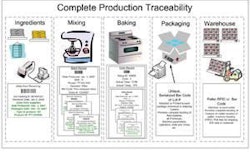
Pet food and its ingredients-for example, meat and meat by-products-are subject to decay by several processes such as autoxidation, microbial growth, flavor/aroma changes or staling. The period before drastic changes occur-the time of freshness-can vary depending on quality of raw ingredients, ingredient processing and storage conditions.
The freshness of ingredients can additionally affect the palatability of the resulting product. Off flavors caused by chemical or microbiological deterioration of ingredients can result in food refusal, since animals rely on their sense of smell and taste to differentiate safe, nutritious foods from those that taste bad or may contain toxic substances.
Role of microbial degradation
One area with significant opportunities is ensuring high quality ingredients to produce palatants for dry kibble coating. For example, the freshness of poultry viscera is regarded as critical for the quality of products prepared from them. Minimizing the time between rendering and manufacturing of the palatant is crucial to maintaining freshness.
To demonstrate this, an evaluation of the time between collection of fresh poultry viscera and manufacture of a palatant flavor was conducted. For the first set of experiments, one portion of viscera was left untreated while another portion was treated with a freshness agent. Both portions were incubated at room temperature, and after 24 hours, the untreated material was again divided into two portions. One portion was treated with the freshness agent and the other was left as the second control.
All the treatments were further incubated for another 24 hours at room temperature. The initial total aerobic count of the untreated poultry viscera rose significantly by two logs within 24 hours. After 48 hours, no further increase in total count was observed, indicating quality of the material as measured by total aerobic growth decreases quickly within the initial 24 hours.
However, when a freshness agent was added to the viscera before storage, development of total aerobes was delayed. After 48 hours, total aerobes in the treated sample had further increased to levels similar to that of untreated viscera stored for 48 hours. So, adding a freshness agent appears to delay microbial degradation of poultry viscera for at least 24 hours, but it needs to be added as quickly as possible.
Similar to total aerobic count, initial enterobacterial count of the untreated increased after 24 hours of incubation at ambient temperature. No further increase was observed after 48 hours of storage. However, when the ground viscera were treated with the freshness agent, there was minimal change in enterobacterial counts, even after 48 hours.
Freshness and palatability
Although analytical measures of factors that influence freshness (such as microbial count) suggest an improvement or control, it must also be evaluated through sensory analysis. The effects of time and preservation of viscera before flavor production were tested in palatability trials.
At the start of this experiment, viscera were divided into six portions. Five portions of viscera were left untreated, while the remaining portion was treated with a freshness agent. All samples were stored at ambient temperature for 24 hours.
Then the treated sample and one untreated sample were used to make Flavors H and C, respectively. Another sample was treated with a freshness agent to evaluate the ability of the agent to rescue the stored raw material. This treated sample was divided into two portions, one of which was used to make Flavor D, while the other was stored for an additional 24 hours. At the 48-hour mark, the remaining samples were used to make Flavors E, F and J.
Palatability of the resulting flavors was assessed using a standard two-pan test with 20 dogs over two consecutive days. Each day the position of the two test foods was switched to avoid influence of position preference over food preference. Both first choice and relative consumption were recorded.
The palatability of flavors prepared from viscera treated immediately after collection of the raw material and stored for up to 48 hours was found to be significantly better than that of digest prepared from untreated viscera stored for the same amount of time. As with microbial degradation, adding the freshness agent needs to happen as quickly as possible, because treatment of viscera stored for 24 hours at room temperature could not rescue the viscera quality and palatability of the flavor.
QA is essential
These results demonstrate the importance of utilizing the freshest raw materials available. Processing and handling measures such as reducing the collection and transit time before raw material chilling and good hygiene of transfer and processing equipment will reduce the risk of microbial degradation and loss of quality. While sound quality assurance practices are essential, freshness agents may also be considered.

















